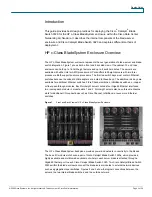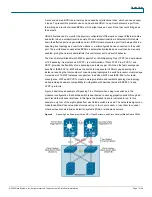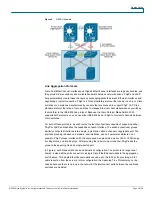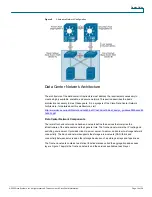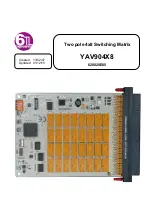
Design Guide
© 2008 Cisco Systems, Inc. All rights reserved. This document is Cisco Public Information.
Page 13 of 28
link redundancy combined with a deterministic topology design to achieve application-availability
requirements. Servers are typically configured with multiple NICs and dual homed to the access
layer switches to provide backup connectivity to the business application.
High availability is an important design consideration in the data center. The Cisco Catalyst Blade
Switch 3020 has numerous features and characteristics that contribute to a reliable, highly
available network.
High Availability for the BladeSystem Switching Infrastructure
High availability between the Cisco Catalyst Blade Switch 3020s in the HP c-Class BladeSystem
and the aggregation layer switches requires link redundancy. Each Cisco Catalyst Blade Switch
3020 in the HP c-Class BladeSystem uses four SFP uplinks for connectivity to the external
network, allowing for redundant paths using two links each for more redundancy. Redundant paths
implemented between the HP c-Class BladeSystem and each aggregation layer switch when each
path uses two links provide a highly resilient design. However, this setup introduces the possibility
of Layer 2 loops; therefore, a mechanism is required to manage the physical topology. The
implementation of RSTP helps ensure a fast-converging, predictable Layer 2 domain between the
aggregation layer and access switches (the Cisco Catalyst Blade Switch 3020s) when redundant
paths are present.
The recommended design is a triangle topology (as shown in Figure 4 earlier), which delivers a
highly available environment through redundant links and a spanning tree. It allows for multiple
switch or link failures without compromising the availability of the data center applications.
These channels support the publicly available subnets in the data center and traffic between
servers. The server-to-server traffic that uses these uplinks is logically segmented through VLANs
and can use network services available in the aggregation layer. There is also a port channel
defined between the two blade-enclosure switches. This path provides intraenclosure connectivity
between the servers for VLANs defined locally on the blade-enclosure switches. Clustering
applications that require Layer 2 communication can use this traffic path, as well as mirrored traffic.
Each of these port channels is composed of two Gigabit Ethernet ports.
RPVST+ is recommended as the method for controlling the Layer 2 domain because of its
predictable behavior and fast convergence. A meshed topology combined with RPVST+ allows only
one active link from each blade switch to the root of the spanning-tree domain. This design creates
a highly available server farm through controlled traffic paths and the rapid convergence of the
spanning tree. The details of the recommended design are discussed in a later section.
High Availability for the Blade Servers
The HP c-Class BladeSystem provides high availability to blade servers by multihoming each
server to the Cisco Catalyst Blade Switch 3020s. The two Cisco Catalyst Blade Switch 3020s
housed in the interconnect bays are connected to the blade server over the backplane. Four
backplane Gigabit Ethernet connections are available to every blade-server slot.
Multihoming the server blades allows the use of a NIC teaming driver, which provides another high-
availability mechanism to fail over and load balance at the server level. Three modes of teaming
are supported:



